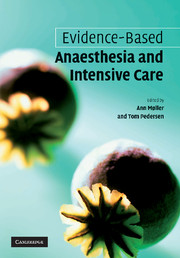Book contents
- Frontmatter
- Contents
- Foreword
- Contributors
- 1 Introducing evidence-based anaesthesia
- 2 How to define the questions
- 3 Developing a search strategy, locating studies and electronic databases
- 4 Retrieving the data
- 5 Critical appraisal and presentation of study details
- 6 Outcomes
- 7 The meta-analysis of a systematic review
- 8 Bias in systematic reviews: considerations when updating your knowledge
- 9 The Cochrane Collaboration and the Cochrane Anaesthesia Review Group
- 10 Integrating clinical practice and evidence: how to learn and teach evidence-based medicine
- 11 Involving patients and consumers in health care and decision-making processes: nothing about us without us
- 12 Evidence-based medicine in the Third World
- 13 Preoperative anaesthesia evaluation
- 14 Regional anaesthesia versus general anaesthesia
- 15 Fluid therapy
- 16 Antiemetics
- 17 Anaesthesia for day-case surgery
- 18 Obstetrical anaesthesia
- 19 Anaesthesia for major abdominal and urological surgery
- 20 Anaesthesia for paediatric surgery
- 21 Anaesthesia for eye, ENT and dental surgery
- 22 Anaesthesia for neurosurgery
- 23 Cardiothoracic anaesthesia and critical care
- 24 Postoperative pain therapy
- 25 Critical care medicine
- 26 Emergency medicine: cardiac arrest management, severe burns, near-drowning and multiple trauma
- Glossary of terms
- Index
20 - Anaesthesia for paediatric surgery
Published online by Cambridge University Press: 05 September 2009
- Frontmatter
- Contents
- Foreword
- Contributors
- 1 Introducing evidence-based anaesthesia
- 2 How to define the questions
- 3 Developing a search strategy, locating studies and electronic databases
- 4 Retrieving the data
- 5 Critical appraisal and presentation of study details
- 6 Outcomes
- 7 The meta-analysis of a systematic review
- 8 Bias in systematic reviews: considerations when updating your knowledge
- 9 The Cochrane Collaboration and the Cochrane Anaesthesia Review Group
- 10 Integrating clinical practice and evidence: how to learn and teach evidence-based medicine
- 11 Involving patients and consumers in health care and decision-making processes: nothing about us without us
- 12 Evidence-based medicine in the Third World
- 13 Preoperative anaesthesia evaluation
- 14 Regional anaesthesia versus general anaesthesia
- 15 Fluid therapy
- 16 Antiemetics
- 17 Anaesthesia for day-case surgery
- 18 Obstetrical anaesthesia
- 19 Anaesthesia for major abdominal and urological surgery
- 20 Anaesthesia for paediatric surgery
- 21 Anaesthesia for eye, ENT and dental surgery
- 22 Anaesthesia for neurosurgery
- 23 Cardiothoracic anaesthesia and critical care
- 24 Postoperative pain therapy
- 25 Critical care medicine
- 26 Emergency medicine: cardiac arrest management, severe burns, near-drowning and multiple trauma
- Glossary of terms
- Index
Summary
This chapter covers selected topics which illustrate the basis for modern general paediatric anaesthesia practices. Sub-specialty topics have not been covered. It is generally agreed that detailed preparation of children and families is vital for success. This includes providing better information upon which consent and assent is gained. Behavioural management decreases psychological upset and reduces the need for sedative premedication. Parental involvement in the pre- and postoperative periods is usually helpful. Many paediatric procedures can be undertaken on a day case basis which has tremendous benefits for children and families. Fasting rules for elective surgery are generally accepted. Topical local anaesthesia prior to venous cannulation for intravenous induction is well-established practice. Sedative premedication has a place and oral midazolam is the most commonly used. Inhalational induction of anaesthesia has undergone a renaissance with the introduction of sevoflurane, although maintenance with sevoflurane can result in emergence delirium. Desflurane maintenance may be particularly useful for neonates. Intravenous induction with propofol is also very common practice and total intravenous anaesthesia (TIVA) and TCI techniques are still being developed for children. Tracheal intubation can be performed safely and effectively in children without muscle relaxants and cuffed tracheal tubes are now more widely used. The laryngeal mask airway (LMA) is very commonly used in paediatric anaesthesia for elective cases and can also be useful in children with difficult airways.
Keywords
- Type
- Chapter
- Information
- Evidence-based Anaesthesia and Intensive Care , pp. 247 - 270Publisher: Cambridge University PressPrint publication year: 2006

